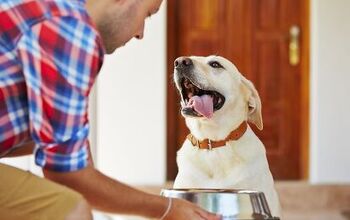5 Things You Need to Know About Dog Growls

As much as you may wish he could, your dog can’t just open his mouth and tell you how he’s feeling. The majority of communication between dogs is done nonverbally but there are times when your dog makes his voice heard. Keep reading to learn everything you need to know about dog growls – what causes them, what they mean, and whether they are cause for concern.
- Dogs Growl for a Reason
If your dog growls at another dog, your first instinct might be to yank on the leash or to tell him to stop it. Before you do, however, think for a moment about what would happen if your dog stopped growling. Growling is a warning signal for dogs – a way for your dog to tell you or another dog that he is feeling unhappy or uncomfortable. If you take away that early warning system, your dog could react in a more volatile way – a way that puts you or another dog in danger.
Related: Top 10 Yappy Dog Breeds
- A Growl Doesn’t Always Mean a Dog is Angry
When your dog growls, it doesn’t necessarily mean he is angry – it’s just another means of communication. When a dog growls, he is saying that something is wrong. Maybe your dog is unhappy or maybe he’s uncomfortable, scared even. It may be an expression of territorial aggression or it might even be a response to pain.
- Growling is a Natural Behavior
Many people who have been bit by a dog claim that the dog didn’t give any warning or that he attacked without reason. The truth is, however, that dogs always give warning, even if it’s something as simple as a low growl. If a dog’s growling is accompanied by aggressive body language, watch out.
Related: How To Stop A Dog From Barking
- There are Different Types of Growl
Dogs always growl for a reason but that reason may vary. Aside from threat growling – a verbal response to fear or aggression – dogs also growl during play or as a request for attention. Dogs may also growl when they are feeling frustrated. The key to understanding why your dog is growling is to take a look at the body language that accompanies it. If your dog is not shying away, flattening his ears, or tensing his body, the growl isn’t intended as a threat.
- Don’t Punish Your Dog for Growling
Your dog growls for many different reasons, so it doesn’t make sense for your response to be the same in each instance. While your first instinct might be to punish your dog for growling, all you will be doing is curbing your dog’s behavior – you won’t actually be addressing the cause for the behavior. Plus, if you punish your dog for growling often enough he may stop doing it entirely and you won’t have any warning if he actually becomes upset and is about to act out. The better response to a dog growl is to examine the situation to determine whether the growl is meant as a threat and, if so, what is the cause.
Dogs exhibit a wide variety of verbal and nonverbal cues that may seem complex but, if you take just a moment to think about them, they are actually fairly easy to interpret. The most important thing to remember about dog behavior is that your dog does everything for a reason. Rather than punishing your dog for a behavior you deem undesirable, take the time to examine and understand the behavior and then come to a resolution.

Kate Barrington is the loving owner of two cats (Bagel and Munchkin) and a noisy herd of guinea pigs. Having grown up with golden retrievers, Kate has a great deal of experience with dogs but labels herself a lover of all pets. Having received a Bachelor's degree in English, Kate has combined her love for pets and her passion for writing to create her own freelance writing business, specializing in the pet niche.
More by Kate Barrington






















